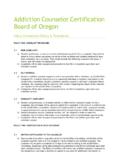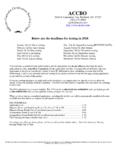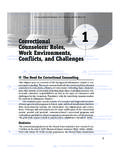Transcription of Mandated Attendance at 12-Step Meetings: Legal …
1 Mandated Attendance at 12-Step Meetings: Legal or Not?Charles W. Hemingway, , , CADC I* A recent 9th Circuit federal court case out of Hawaii, Inouye v. Kemna, has gener-ated great interest in the Oregon addictions counseling community because it involves 12 step Facilitation treatment - and referral to 12-Step programs - as a component of treat-ment. First, Oregon is within the 9th Circuit so the law of the case applies here. Second, there is at least one pending case in federal court in Oregon in which similar issues are raised. The treatment fi eld needs to be mindful of this ruling and at the same time not over-react by eliminating all mention of 12 step programming and eliminating all referrals to 12 step programs. Although most clients don t, addictions counselors know that it is not uncommon for occasional clients to object to AA/NA meeting Attendance as part of a treatment plan on the basis that they (the clients) don t want to participate in religion, or more specifi cally Judeo-Christian religion.
2 Opponents of 12-Step approaches argue that the Inouye case stands for the proposi-tion that no person can ever be referred to AA or NA as a condition of treatment, includ-ing by an addictions counselor with a non-governmental treatment facility. That interpre-tation is over-broad. It is not what the case stands for at all. The purpose of this article is to clear the air and suggest an appropriate analytical approach that can be used by addic-tions counselors and others, notably parole and probation offi cers. Facts of the Case Ricky Inouye was a long-time meth addict, frequently in and out of prison and jail. Referred to treatment while incarcerated, Inouye would grieve about having to attend 12-Step meetings as a part of these treatment programs. But at some point he had enough. In 2000 he sued the state over being placed in treatment programs that required 12-Step meeting Attendance .
3 That case was settled and is not a part of this decision. The important point is that just before his release on parole, Inouye s attorney wrote a letter to the Hawaii Paroling Authority stating that Inouye was a Buddhist and objected on religious grounds to being required to participate in AA 12-Step meetings as a condition of his parole. The attorney requested assurances that there would be no reli-gious content in any treatment program imposed as a requirement of Inouye s parole. Inouye was paroled but a condition of his parole gave his parole offi cer the au-thority to order him into treatment. His parole offi cer knew about the letter and did not initially direct Inouye into treatment. But Inouye relapsed on meth and was arrested for trespassing (having gone to a hotel, where he got high and refused to leave after check-out time).
4 Page One After he was arrested, Inouye s parole offi cer ordered him into a Salvation Army treatment program that required participation in AA/NA meetings. Inouye stayed in the program for a few months but was terminated for treatment noncompliance he contin-ued to use drugs and did not attend any treatment sessions. His parole offi cer had him arrested and jailed. At that point Inouye raised as a defense that the reason he didn t want to go to treatment was that he was required to attend AA/NA Result Before the case was decided Inouye died and his son was allowed to take over pur-suing the case on behalf of Inouye s estate. Inouye (and his son as representative of the estate) was suing under a federal statute that allows an award of money damages where it can be shown that a law enforcement offi cial abridged the basic constitutional rights of an individual.
5 Inouye s lawyers had to show what constitutional right was abridged. Inouye s lawyers argued that the constitutional right abridged was the Establish-ment Clause of the First Amendment in the Constitution: Congress shall make no law respecting an establishment of That s where the letter comes in. Inouye raised the objection in the letter and his parole offi cer s later action in directing him only into the Salvation Army program was seen by the court as governmentally compelled participation in AA/NA programs and that these programs involve substantial religious components . This, the court found, violated the Establishment Clause. The concurring opinion notes that courts have recognized that the principal and primary effect of encouraging participation in AA/NA by parole and probation offi cers is not to advance religious belief but to treat substance abuse.
6 The majority opinion had no objection with the concept that the principal and primary effect of encouraging AA/NA participation being treatment. In fact, the court noted that its decision is in no way meant to denigrate the fi ne work of AA/NA . The court, in a concluding footnote, even stated: We do not decide, when, if at all, (emphasis added) non-coercive state endorsement or encouragement of participation in AA/NA or other religion-based programs is unconstitutional. But it was the letter and the parole offi cer s failure to act in accordance with the let-ter that the court found pushed the matter into being an Establishment Clause violation. Inouye s lawyer had raised the religion issue up front and had asked for an accommoda-tion but the parole offi cer ignored it and offered only the Salvation Army program and no other.
7 Opponents of 12-Step approaches are seeking to latch onto this ruling and boot-strap the ruling into a broad prohibition against AA/NA meeting Attendance as a part of treatment, when that is not the case. It is a court ruling that is limited to the facts of the case In fact, there are some recent developments in federal law that the court in Inouye recognized. Four law professors who specialize in constitutional religious freedom issues have suggested in a 2005 law journal article that Cutter v. Wilkinson, a 2005 Supreme Court case, creates space for Mandated treatment programs with substantial religious components such as AA/NA. But the court in Inouye said it disagreed with the analysis proposed by these professors. Thus, to coin a phrase, the jury may still be out. It may be that what lawyers hope for will happen a different Circuit court will render a different Page Twodecision, creating a split among the Circuits that the Supreme Court can Analytical Framework Until that happens, what can we take from the Inouye case?
8 First, it is clear that for a parole or probation offi cer to directly require a client to attend AA/NA meetings where the client objects violates the Establishment Clause. There is no constitutional prohibition to a person being referred involuntarily to treat-ment as part of a court sentence or as a condition of parole or probation. Thus, it is con-stitutionally permissible for a parole or probation offi cer to direct a client to enter treat-ment. That involves a secular purpose treating substance abuse. Second, the Inouye case adds the component that it is incumbent on the client to raise the objection based on religious grounds. In Inouye s case, he had the letter his attorney had sent to the parole board protesting that he was a Buddhist and objecting to 12-Step meeting involvement on that basis. If the client raises no initial objections, the matter is moot.
9 Third, if the client subsequently raises an objection based on religious grounds, the parole or probation offi cer can offer the client alternatives at that point. This is where Inouye s parole offi cer erred. He offered Inouye only one option. (The concurring opin-ion notes that Inouye never objected to having this one option and enrolled in the Salva-tion Army program, objecting only later when he was sanctioned for non-compliance with treatment). If the client is terminated from treatment for non-compliance as was the cir-cumstance in Inouye s case it is important to look at the other reasons for termination (failure to attend groups, positive drug screens, etc., as well as objections to AA/NA Attendance ). And, where the client attempts to raise an Establishment Clause issue as a defense to being sanctioned, the state can raise the issue of consent and waiver and that the client is acting only to avoid sanctions.
10 That approach would have been possible for the state in Inouye s case but it was not raised early enough in the proceedings and the court said when the state did try to raise it, it was too late. Fourth, note the total absence in this case (and in all other cases that have ad-dressed the AA/NA issue as a part of a treatment protocol) of limitations imposed by the decision on private treatment facilities. There are none. In the Inouye case there was never an issue that the Salvation Army program violated Inouye s rights under the Es-tablishment Clause. It is constitutionally permissible under all the federal and state cases that have been decided for a non-governmental treatment facility to include, as part of a treatment plan, Attendance at AA/NA or other 12-Step meetings for clients. For clients who balk at such a requirement on religious grounds, that becomes a management issue.












